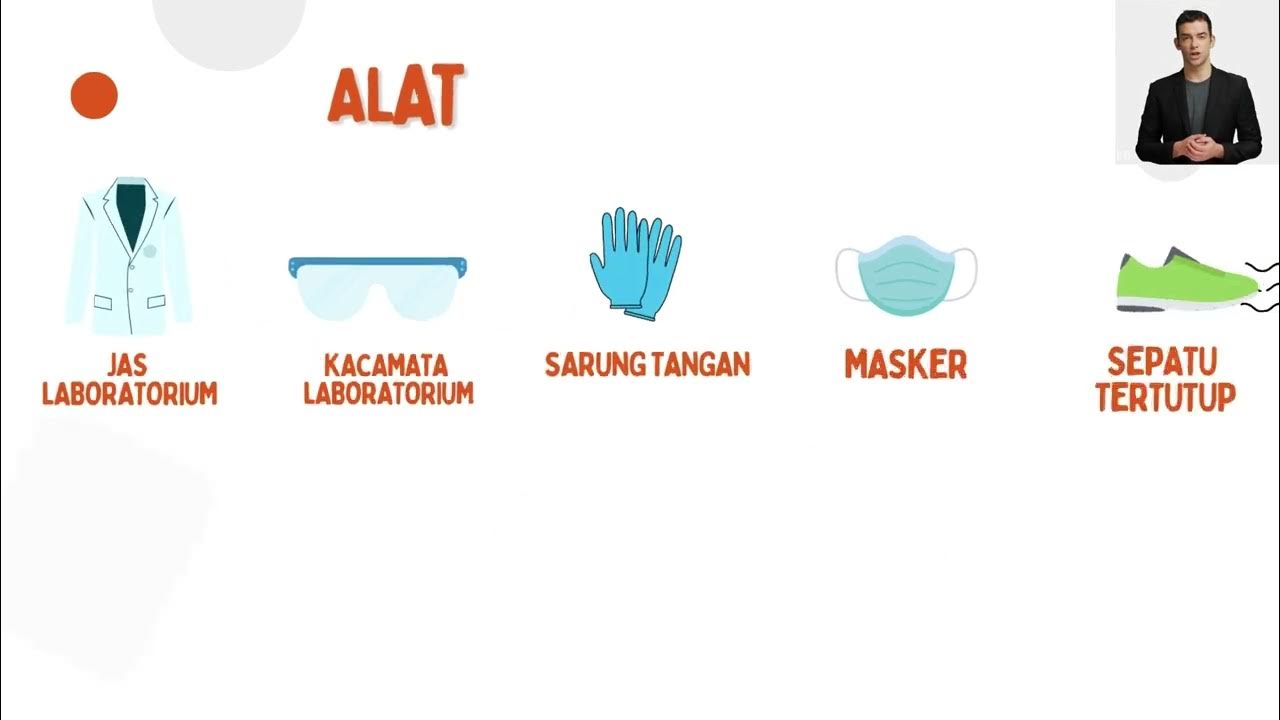Normas de segurança no laboratório de Química
Summary
TLDRThis practical chemistry laboratory lesson emphasizes essential safety protocols to ensure a secure working environment. Key points include the use of personal protective equipment (PPE), such as lab coats, gloves, and safety goggles, as well as strict laboratory conduct. The video stresses avoiding distractions, no smoking, eating, or drinking, and never working alone. Additionally, proper handling of chemicals, equipment, and following detailed instructions are critical for preventing accidents. The session concludes with the importance of cleanliness, washing hands, and maintaining a tidy workspace for future users.
Takeaways
- 😀 Always wear personal protective equipment (PPE) like lab coats, gloves, and safety goggles to prevent exposure to harmful substances.
- 😀 Keep focus and avoid distractions such as conversations or jokes to reduce the risk of accidents in the laboratory.
- 🚭 Smoking is prohibited in the lab due to the risk of explosions caused by flammable chemicals.
- 🥤 Eating and drinking in the lab is strictly forbidden to prevent contamination from toxic substances.
- 👥 Never work alone in the lab; always work with at least one other person to ensure safety.
- 🕒 Avoid working in the lab outside normal hours when supervision might not be available.
- 📚 Always read and understand the instructions carefully before starting any experiment to ensure correct procedures.
- 🔧 Double-check equipment setups before use to ensure all components are securely in place and avoid accidents.
- ⚗️ When mixing chemicals, always add acid to water (not the other way around) to prevent dangerous reactions and burns.
- 👃 Never inhale fumes or attempt to taste any chemicals in the lab, as they may be harmful or toxic.
- 🧼 Clean all used equipment thoroughly after each experiment and leave the lab tidy for the next person.
Q & A
Why is it important to use personal protective equipment (PPE) in a chemistry laboratory?
-Personal protective equipment (PPE) such as lab coats, gloves, safety goggles, long pants, and closed-toe shoes protect individuals from hazardous chemicals and substances that could cause burns, injuries, or health problems when spilled or splashed.
What are the risks associated with smoking in a laboratory?
-Smoking in a laboratory is prohibited because the presence of highly flammable substances increases the risk of explosions. Even a small spark from a cigarette can lead to dangerous chemical reactions and accidents.
Why is eating and drinking not allowed in a laboratory?
-Eating and drinking in the laboratory is prohibited because chemicals can contaminate food and beverages. If substances come into contact with food or drink, they may be ingested, leading to poisoning or other health issues.
What should you do before starting any practical activity in the laboratory?
-Before starting any experiment, you should read and understand all instructions and safety guidelines. This ensures that the procedure is followed correctly and minimizes the risk of accidents or mistakes.
Why is it important to avoid working alone in the laboratory?
-Working with a partner or under supervision is important for safety reasons. In case of an emergency, having someone else present can provide immediate help, and it also ensures that safety protocols are followed.
What is the proper way to handle acids and water in a chemistry lab?
-When mixing acids and water, always add acid to water, not the other way around. Adding water to acid can cause a violent reaction that releases a large amount of heat, which may lead to burns or explosions.
Why should you never inhale or taste chemicals in the laboratory?
-Inhaling or tasting chemicals is extremely dangerous as many substances are toxic or harmful to health. Some chemicals may release toxic fumes, and others can cause severe burns or poisoning if ingested.
What are the consequences of running or playing in the laboratory?
-Running or playing in the laboratory can lead to accidents such as tripping, spilling dangerous substances, or causing equipment to fall. It's important to maintain focus and avoid distractions to ensure safety.
What should you do if you spill a substance in the laboratory?
-If you spill a substance in the laboratory, immediately clean it up and inform your instructor. Make sure to follow the correct procedures for handling spills, which may involve using specific cleaning materials or neutralizing agents.
What is the proper procedure for cleaning up after a practical session in the lab?
-After completing an experiment, wash all glassware and equipment thoroughly. Clean the lab benches, dispose of waste properly, and ensure the lab is left organized for the next session. It is also important to wash your hands to remove any chemical residues.
Outlines

This section is available to paid users only. Please upgrade to access this part.
Upgrade NowMindmap

This section is available to paid users only. Please upgrade to access this part.
Upgrade NowKeywords

This section is available to paid users only. Please upgrade to access this part.
Upgrade NowHighlights

This section is available to paid users only. Please upgrade to access this part.
Upgrade NowTranscripts

This section is available to paid users only. Please upgrade to access this part.
Upgrade NowBrowse More Related Video

Keselamatan dan Kesehatan Kerja (K3) di Laboraturium Kimia

Praktikum Kimia Dasar Modul 1. Pengenalan Alat Laboratorium

Sécurité au laboratoire

Persiapan Sebelum Praktikum/Bekerja di Laboratorium | Keselamatan Kerja di Laboratorium Kimia Ep 1

Aula Prática: EPI's e EPC's no Laboratório de Química

Keselamatan Kerja di Laboratorium IPA Mata Kuliah Pendalaman Materi IPA
5.0 / 5 (0 votes)